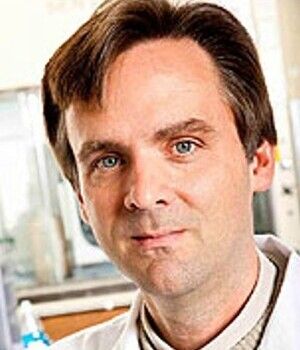My lab mainly studies the biochemistry of viral proteins and small molecules that interact with them in order to discover new antiviral drugs. Our main interest, presently, is in targeting helicases encoded by:
Helicases are motor proteins that separate DNA and RNA duplexes and dislodge proteins bound to nucleic acids in reactions fueled by ATP hydrolysis. We also study helicases from human cells, and other viral proteins as drug targets including polymerases, proteases and capsid proteins. The goal of most projects in the lab is either to understand how these proteins help copy viral genomes or to understand how small molecule drugs block virus growth by directly interfering with these important enzymes.
Virdi, R S., Bavisotto, R V., Hopper, N C., Vuksanovic, N, Melkonian, T R., Silvaggi, Nicholas R., and Frick, David N.
“Discovery of Drug-Like Ligands for the Mac1 Domain of SARS-CoV-2 Nsp3” SLAS discovery : advancing life sciences R & D25.10 (2020): 1162-1170.
Corby, M J., Stoneman, M R., Biener, G, Paprocki, J D., Kolli, R, Raicu, Valerica, and Frick, David N.
“Quantitative microspectroscopic imaging reveals viral and cellular RNA helicase interactions in live cells” The Journal of biological chemistry292.27 (2017): 11165-11177.
Bassetto, M, Leyssen, P, Neyts, J, Yerukhimovich, M M., Frick, David N., and Brancale, A.
“Computer-aided identification, synthesis and evaluation of substituted thienopyrimidines as novel inhibitors of HCV replication” European journal of medicinal chemistry123. (2016): 31-47.
Bassetto, M, Ferla, S, Leyssen, P, Neyts, J, Yerukhimovich, M M., Frick, David N., O'Donnell, R, and Brancale, A.
“Novel symmetrical phenylenediamines as potential anti-hepatitis C virus agents” Antiviral chemistry & chemotherapy(2016).
Bassetto, M, Leyssen, P, Neyts, J, Yerukhimovich, M M., Frick, David N., Courtney-Smith, M, and Brancale, A.
“In silico identification, design and synthesis of novel piperazine-based antiviral agents targeting the hepatitis C virus helicase” European journal of medicinal chemistry125. (2016): 1115-1131.
Kaushik-Basu, N, Ratmanova, N K., Manvar, D, Belov, D S., Cevik, O, Basu, A, Yerukhimovich, M M., Lukyanenko, E R., Andreev, I A., Belov, G M., Manfroni, G, Cecchetti, V, Frick, David N., Kurkin, A V., Altieri, A, and Barreca, M L.
“Bicyclic octahydrocyclohepta[b]pyrrol-4(1H)one derivatives as novel selective anti-hepatitis C virus agents” European journal of medicinal chemistry122. (2016): 319-25.
Sweeney, Noreena L., Alicia, Hanson M., Mukherjee, Sourav, Ndjomou, Jean, Geiss, Brian J., Steel, John J., Li, Kelin, Frankowski, Kevin J., Schoenen, Frank J., and Frick, David N.
“Benzothiazole and Pyrrolone Flavivirus Inhibitors Targeting the Viral Helicase” ACS Infect. Dis1. (2015): 140-148.
Provazzi, P J., Mukherjee, S, Hanson, A M., Nogueira, M L., Carneiro, B M., Frick, David N., and Rahal, P.
“Analysis of the Enzymatic Activity of an NS3 Helicase Genotype 3a Variant Sequence Obtained from a Relapse Patient” PloS one10.12 (2015): e0144638.
Ndjomou, Jean, Corby, M. J., Sweeney, Noreena L., Hanson, Alicia M., Aydin, Cihan, Ali, Akbar, Schiffer, Celia A., Li, Kelin, Frankowski, Kevin J., Schoenen, Frank J., and Frick, David N.
“Simultaneously Targeting the NS3 Protease And Helicase Activities For More Effective Hepatitis C Virus Therapy” ACS Chem. Biol10. (2015).
Andreev, Ivan A., Manvar, Dinesh, Barreca, Maria Letizia L., Belov, Dmitry S., Basu, Amartya, Sweeney, Noreena L., Ratmanova, Nina R., Lukyanenko, Evgeny R., Manfroni, Giuseppe, Cecchetti, Violetta, Frick, David N., Altieri, Andrea, Kaushik-Basu, Neerja, and Kurkin, Alexander V.
“Discovery of the 2-phenyl-4,5,6,7-Tetrahydro-1H-indole as a novel anti-hepatitis C virus targeting scaffold” European Journal of Medicinal Chemistry96. (2015): 250-8.
Mukherjee, Sourav, Weiner, Warren S., Schroeder, Chad E., Simpson, Denise S., Hanson, Alicia M., Sweeney, Noreena L., Marvin, Rachel K., Ndjomou, Jean, Kolli, Rajesh, Isailovic, Dragan, Schoenen, Frank J., and Frick, David N.
“Ebselen Inhibits Hepatitis C Virus NS3 Helicase Binding to Nucleic Acid and Prevents Viral Replication” ACS Chemical Biology9. (2014): 2393-2403.
Sweeney, Noreena L., Shadrick, William W., Mukherjee, Sourav, Li, Kelin, Frankowski, Kevin J., Schoenen, Frank J., and Frick, David N.
“Primuline Derivatives That Mimic RNA To Stimulate Hepatitis C Virus NS3 Helicase-Catalyzed ATP Hydrolysis” J. Biol. Chem288. (2013): 19949-19957.
Mannan, M. Amin-ul , Shadrick, William R., Biener, Gabriel, Anshu, Ashish, Raicu, Valerica, Frick, David N., and Dey, Madhusudan.
“An Ire1-Phk1 Chimera Reveals a Dispensable Role of Autokinase Activity in Endoplasmic Reticulum Stress Response” J. Mol. Biol425. (2013): 2083-99.

